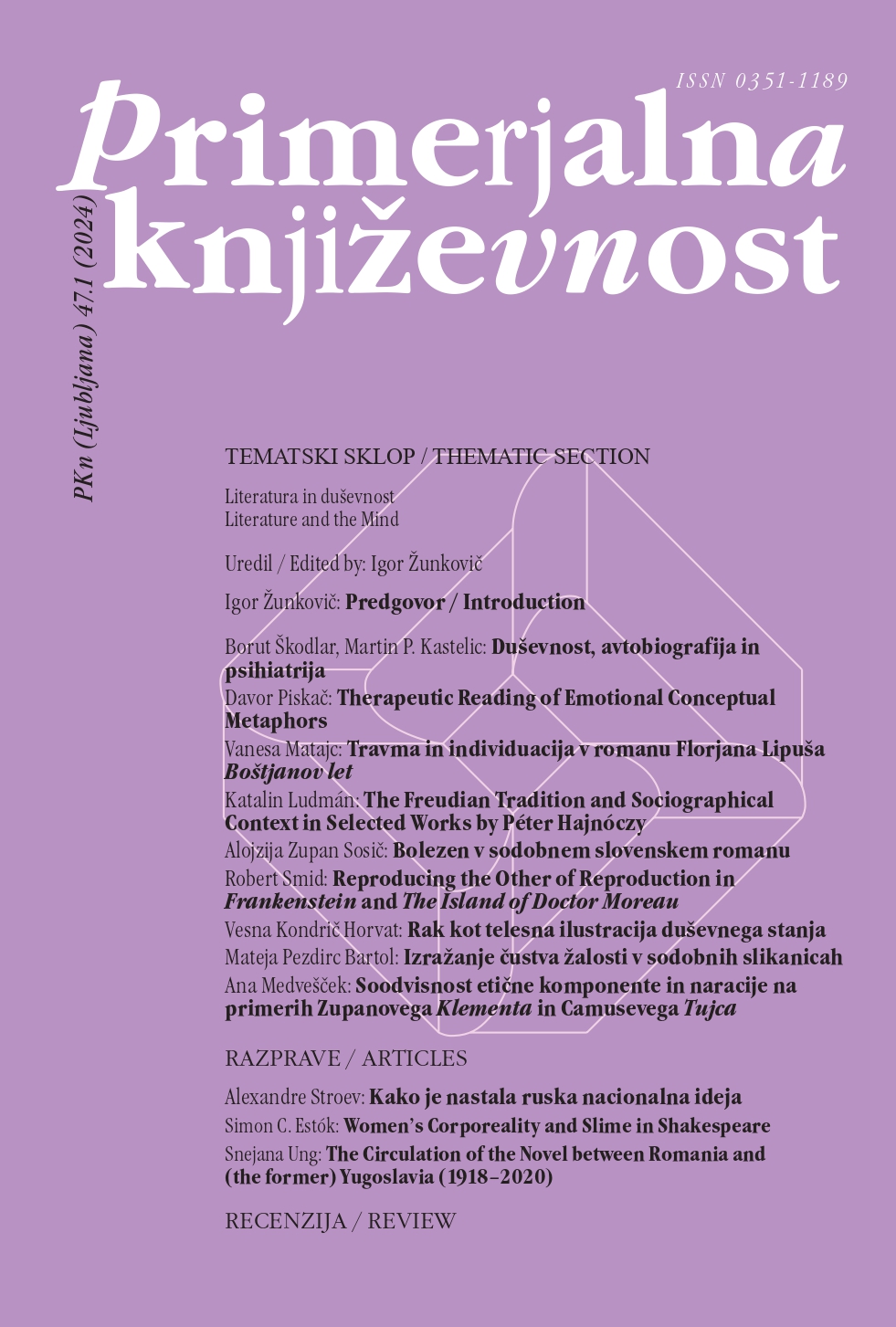Women’s Corporeality and Slime in Shakespeare: Staging the Anthropocene
DOI:
https://doi.org/10.3986/pkn.v47.i1.11Keywords:
English drama, Shakespeare, William, women, misogyny, bodily deliquescence, vaginophobia, slime, ecocriticismAbstract
The entanglements of environment, misogyny, and fear of slime in Shakespeare’s text and time effectively foreshadow the Anthropocene. To understand this staging, it is necessary first to understand basic theories about slime. Amidst the dearth of such theories are proclamations that it is a transgressive, element-defying matter that generates fear and disgust, matter that threatens degeneration and dissolution even as it remains fundamental to the origin and continuity of life. A central insight of the new materialist theory concerns the agency of nonhuman things, and slime exhibits such agency in ways that evoke various kinds of fear. Jean-Paul Sartre offers interesting insights that become all the more valuable when—in the moment of theorizing slime—he genders it and imbues it with his fears and his version of misogyny. It is necessary to look at this sexist rendering rather than act as a Sartre apologist because so doing helps us to understand how slime is elemental to theorizing about both misogyny and ecophobia. In discussing the early modern period, the most convenient point of entry to these topics is the staging of vaginophobia.
References
Alberti, Fay Bound. “A Darke and Vicious Place: Conceptualizing the Vagina: How Women’s Sex Organs Have Been Understood in Art and in History.” Literary Hub, 25 July 2016, https://lithub.com/a-darke-and-vicious-place-conceptualizing-the-vagina/. Accessed 8 April 2024.
Barnes, Hazel E. “Sartre and Sexism.” Philosophy and Literature, vol. 14, no. 2, 1990, pp. 340–347.
Behringer, Wolfgang. “Climactic Change and Witch-Hunting: The Impact of the Little Ice Age on Mentalities.” Climate Change, vol. 43, no.1, 1999, pp. 335–351.
Brayton, Daniel. “Shakespeare and Slime: Notes and the Anthropocene.” Ecological Approaches to Early Modern English Texts: A Field Guide to Reading and Teaching, edited by Jennifer Munroe, Edward J. Geisweidt and Lynne Bruckner, Ashgate, 2015, pp. 81–89.
Bredbeck, Gregory W. Sodomy and Interpretation: Marlowe to Milton. Cornell University Press, 1991.
Camara, Anthony. “Abominable Transformations: Becoming-Fungus in Arthur Machen’s The Hill of Dreams.” Gothic Studies, vol. 16, no. 1, 2014, pp. 9–23.
Carroll, Noël. The Philosophy of Horror, or Paradoxes of the Heart. Routledge, 1990.
Chiari, Sophie. Shakespeare’s Representation of Weather, Climate and Environment: The Early Modern “Fated Sky”. Edinburgh University Press, 2019.
Cohen, Ed. “Are We (Not) What We Are Becoming? ‘Gay,’ ‘Identity,’ ‘Gay Studies,’ and the Disciplining of Knowledge.” Engendering Men: The Question of Male Feminist Criticism, edited by Joseph A. Boone and Michael Cadden, Routledge, 1990, pp. 161–175.
Collins, Margery, and Christine Pierce. “Holes and Slime: Sexism in Sartre’s Psychoanalysis.” Women and Philosophy: Toward a Theory of Liberation, edited by Carol C. Gould and Marx W. Wartofsky, Putnam’s Sons, 1976, pp. 112–127.
Estók, Simon C. The Ecophobia Hypothesis. Routledge, 2018.
Estók, Simon C. “Environmental Implications of the Writing and Policing of the Early Modern Body: Dismemberment and Monstrosity in Shakespearean Drama.” Shakespeare Review, vol. 33, 1998, pp. 107–142.
Estók, Simon C. “The Slimic Imagination and Elemental Eco-Horror.” ZAA: Zeitschrift für Anglistik und Amerikanistik, vol. 70, no. 1, 2022, pp. 59–74.
Foucault, Michel. The History of Sexuality—Volume 1: An Introduction. Translated by Robert Hurley, Vintage, 1990.
Gaard, Greta. “New Directions for Ecofeminism: Toward a More Feminist Ecocriticism.” ISLE: Interdisciplinary Studies in Literature and Environment, vol. 17, no. 4, 2010, pp. 643–665.
Gaard, Greta. “Green, Pink, and Lavender: Banishing Ecophobia Through Queer Ecologies.” Ethics and Environment, vol. 16, no. 2, 2011, pp. 155–226.
Grosz, Elizabeth. Volatile Bodies: Towards a Corporeal Feminism. Indiana University Press, 1994.
Hurley, Kelly. The Gothic Body: Sexuality, Materialism, and Degeneration at the Fin de Siècle. Cambridge University Press, 1996.
Laqueur, Thomas. Making Sex: Body and Gender from the Greeks to Freud. Harvard University Press, 1990.
Marchesini, Roberto. The Virus Paradigm: A Planetary Ecology of the Mind. Translated by Sarah De Sanctis, Cambridge University Press, 2021.
Mui, Constance. “Sartre’s Sexism Reconsidered.” Auslegung, vol. 16, no. 1, 1990, pp. 31–41.
Nussbaum, Martha. “The Roots of Male Rage, on Show at the Kavanaugh Hearing.” The Washington Post, 29 September 2018, https://www.washingtonpost.com/news/democracy-post/wp/2018/09/29/the-roots-of-male-rage-on-show-at-the-kavanaugh-hearing/. Accessed 4 April 2024.
Paglia, Camille. Sexual Personae: Art and Decadence from Nefertiti to Emily Dickinson. Vintage, 1990.
Paster, Gail Kern. The Body Embarrassed: Drama and the Disciplines of Shame in Early Modern England. Cornell University Press, 1993.
Read, Sara. Menstruation and the Female Body in Early Modern England. Palgrave, 2013.
Sartre, Jean-Paul. Being and Nothingness: A Phenomenological Essay on Ontology. Translated by Hazel E. Barnes, Washington Square, 1984.
Shakespeare, William. King Lear. The Riverside Shakespeare, 2nd Edition, edited by G. Blakemore Evans et al., Houghton Mifflin, 1997, pp. 1297–1354.
Shakespeare, William. Titus Andronicus. The Riverside Shakespeare, 2nd Edition, edited by G. Blakemore Evans et al., Houghton Mifflin, 1997, pp. 1065–1100.
Shakespeare, William. “Sonnet 153.” The Riverside Shakespeare, 2nd Edition, edited by G. Blakemore Evans et al., Houghton Mifflin, 1997, p. 1871.
Shakespeare, William. Hamlet. The Riverside Shakespeare, 2nd Edition, edited by G. Blakemore Evans et al., Houghton Mifflin, 1997, pp. 1183–1245.
Sharp, Jane. The Midwives Book; or, the Whole Art of Midwifry Discovered. Edited by Elaine Hobby, Oxford University Press, 1999.
Wedlich, Susanne. Slime: A Natural History. Granta, 2021.
Weisman, Alan. The World Without Us. Picador, 2007.
Wilson, Robert Rawdon. The Hydra’s Tale: Imagining Disgust. University of Alberta Press, 2002.


